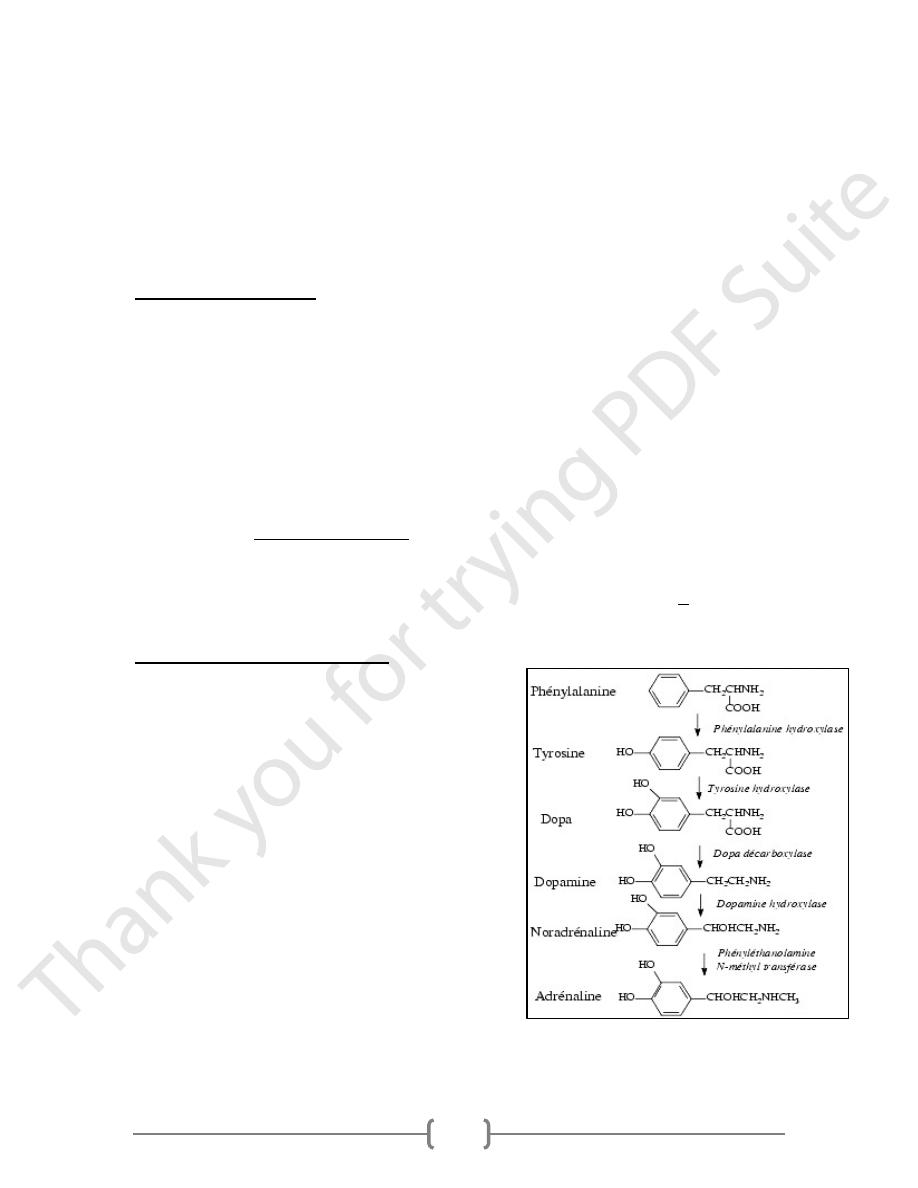
23
Lec.7: Adrenal Medulla
The adrenal medulla is a source of the catecholamines. The medulla is richly innervated
by preganglionic sympathetic fibers and is, in essence, an extension of the sympathetic
nervous system. The chromaffin cells are the principle cell type that secret
catacholamines
The catecholamines are
o norepinephrine (NE) or called noradrenaline),
o epinephrine (E) or called adrenaline),
o Dopamine.
o These hormones are water soluble.
Norepinephrines the principal product synthesized in the CNS, and epinephrine is the
principal catecholamine produced by the adrenal glands.
Both norepinephrine and epinephrine influence the vascular system, in addition
epinephrine affects metabolic processes such as carbohydrate metabolism.
The effects of epinephrine and norepinephrineare initiated by their binding to adrenergic
receptors on the surface of target cells. These receptors are coupled to G proteins, which
stimulate or inhibit intracellular signaling pathways. •The actions of the catecholamines
are initiated through their interaction with two different types of specific cell membrane
receptors, the alpha-adrenergic and beta-adrenergic receptors (α
1
, α
2
,β
1
,β
2
)
Synthesis of Catecholamines
The biosynthesis pathway begins with the amino
acid tyrosine. The first step in the pathway is the
committed step for catecholamine synthesis.
Tyrosine hydroxylase catalyzes the rate limiting
step for the production of epinephrine and
norepinephrine, the conversion of tyrosine to
dihydroxyphenylalanine (DOPA).
Dihydroxyphenylalanine is converted to dopamine
by DOPA decarboxylase.
Norepinephrine is produced from dopamine by
dopamine b-hydroxylase (DBH).
The human adrenal medulla produces and releases
about 80% epinephrine and 20% norepinephrine,
with a small amount of dopamine.

24
Dopamine
o In the brain, dopamine functions as a neurotransmitter, activating dopamine receptors.
o Dopamine is also a neurohormone released by the hypothalamus.
o Its main function as a hormone is to inhibit the release of prolactin from the anterior
lobe of the pituitary
Major effects of catacholamine:
1) Increased rate and force of contraction of the heart muscle
2) Constriction of blood vessels:
Norepinephrine, in particular, causes widespread vasoconstriction, resulting in increased
resistance and hence arterial blood pressure.
3) Dilation of bronchioles: Assists in pulmonary ventilation.
4) Stimulation of lipolysis in fat cells:
This provides fatty acids for energy production in many tissues and aids in conservation
of reserves of blood glucose.
5) Increased metabolic rate:
Oxygen consumption and heat production increase throughout the body in. Medullary
hormones also promote breakdown of glycogen in skeletal muscle to provide glucose for
energy production.
6) Dilation of the pupils:
Important in situations under conditions of low ambient light.
Catecholamine response to short-term stress; hence norepinephrine and epinephrine
increase the heart rate as well as blood pressure. Other actions of norepinephrine include
increased glycogenolysis (the conversion of glycogen to glucose) in the liver, increased
lipolysis (the conversion of fats to fatty acids in adipose tissue, and relaxation of
bronchial smooth muscle to open up the air passages to the lungs. All of these actions
represent a mobilization of the body's resources in order to meet the stressful challenge
such a response is often termed the “flight or fight” syndrome.
Stimuli causing release of adrenal medulla hormones:
o exercise,
o hypoglycaemia,
o haemorrhage
o and emotional distress
excess secretion of catecholamine may be caused by tumor of chromaffin cells and is
called pheochromocytoma

25
Parathyroid glands
Parathyroid glands are Four endocrine glands found posterior to the thyroid gland.
Biological Activity of PTH
Bone
PTH stimulated bone resorption releases calcium & phosphate into blood
Kidney
PTH increases reabsorption of calcium & reduces reabsorption of phosphate –Net effect
of its action is increased calcium & reduced phosphate in plasma
Intestine
Increases calcium reabsorption via vitamin D
Biosynthesis, Storage & Secretion of PTH
PTH is synthesized as the preprohormone (Preproparathyroid Hormone) by parathyroid
gland.
The active form of PTH is cleaved from the preprohormone before release from the gland
PTH is released by exocytosis in response to reduced plasma calcium.
Vitamin D feeds back to reduce PTH secretion as a secondary mechanism
It is synthesized as the preprohormone & released in response to high plasma calcium,
Net result of its action is a decline in plasma calcium & phosphate.
Calcitonin acts on bone osteoclasts to reduce bone resorption.
